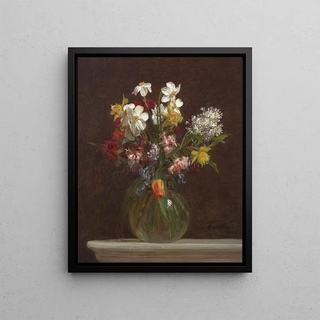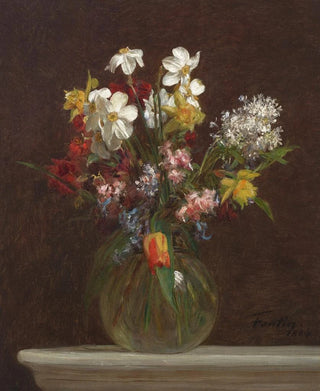Art print | White narcissuses, hyacinths and tulips - Henri Fantin-Latour


View from behind

Frame (optional)
Narcissus White, Hyacinths, and Tulips - Henri Fantin-Latour – Captivating Introduction
In a world where nature reveals itself with infinite grace, the artwork "Narcissus White, Hyacinths, and Tulips" by Henri Fantin-Latour stands as a tribute to the fleeting beauty of flowers. This floral composition, imbued with delicacy, invites the viewer to immerse themselves in a universe where each petal tells a story. The art print of this iconic piece allows for a rediscovery of Fantin-Latour's mastery and sensitivity, which shine through in every shade of color and every meticulous detail. Observing this painting, one feels a deep connection with nature, as if the flowers, through their simple presence, manage to capture the very essence of life.
Style and uniqueness of the work
Henri Fantin-Latour, a 19th-century painter, excels in the art of still life, and "Narcissus White, Hyacinths, and Tulips" is a perfect example. The composition of the work is carefully orchestrated, harmoniously blending shapes and colors. The white narcissus, with its pure glow, stands proudly alongside vibrant hyacinths and gracefully contoured tulips. This juxtaposition creates a captivating visual balance, where each flower seems to dialogue with the others. The play of light, subtly rendered, accentuates the texture of the petals, bringing this floral scene to life. The artist, through his realistic approach, manages to transcend simple representation to offer a unique sensory experience. The color palette, both soft and vibrant, evokes the freshness of spring, inviting the viewer to immerse themselves in a lush garden.
The artist and his influence
Henri Fantin-Latour, an emblematic figure of the Impressionist movement, knew how to mark his era with his distinctive style and passion for nature. Born in 1836, he was influenced by the great masters of his time, while developing a personal approach that is uniquely his own. His interest in flowers, which he often depicted in his works, reflects his admiration for natural beauty and his desire to capture the essence of life.

Matte finish

View from behind

Frame (optional)
Narcissus White, Hyacinths, and Tulips - Henri Fantin-Latour – Captivating Introduction
In a world where nature reveals itself with infinite grace, the artwork "Narcissus White, Hyacinths, and Tulips" by Henri Fantin-Latour stands as a tribute to the fleeting beauty of flowers. This floral composition, imbued with delicacy, invites the viewer to immerse themselves in a universe where each petal tells a story. The art print of this iconic piece allows for a rediscovery of Fantin-Latour's mastery and sensitivity, which shine through in every shade of color and every meticulous detail. Observing this painting, one feels a deep connection with nature, as if the flowers, through their simple presence, manage to capture the very essence of life.
Style and uniqueness of the work
Henri Fantin-Latour, a 19th-century painter, excels in the art of still life, and "Narcissus White, Hyacinths, and Tulips" is a perfect example. The composition of the work is carefully orchestrated, harmoniously blending shapes and colors. The white narcissus, with its pure glow, stands proudly alongside vibrant hyacinths and gracefully contoured tulips. This juxtaposition creates a captivating visual balance, where each flower seems to dialogue with the others. The play of light, subtly rendered, accentuates the texture of the petals, bringing this floral scene to life. The artist, through his realistic approach, manages to transcend simple representation to offer a unique sensory experience. The color palette, both soft and vibrant, evokes the freshness of spring, inviting the viewer to immerse themselves in a lush garden.
The artist and his influence
Henri Fantin-Latour, an emblematic figure of the Impressionist movement, knew how to mark his era with his distinctive style and passion for nature. Born in 1836, he was influenced by the great masters of his time, while developing a personal approach that is uniquely his own. His interest in flowers, which he often depicted in his works, reflects his admiration for natural beauty and his desire to capture the essence of life.






